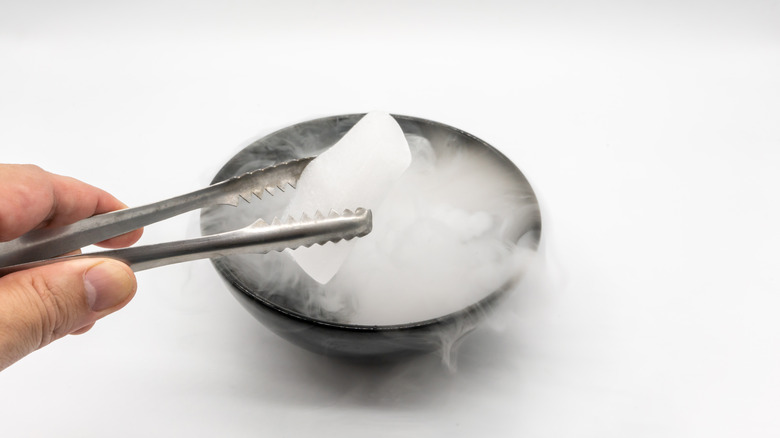What Really Happens To Your Body If You Eat Dry Ice?
Dry ice is commonly used in pharmaceuticals (as a cooling agent for medicines and vaccines), film (to create special effects), manufacturing (to freeze pipes), healthcare (to store organs for transplant), and the hospitality industry (to preserve ice creams and meat), per HowStuffWorks, .
Also known as solidified carbon dioxide, it is so cold (a block of dry ice has a surface temperature of -109°F) that it can cause severe frostbite and skin burn if touched without protective gloves (via the University of Washington). In addition, since it escapes the liquid state, sublimates, and expands into a gas quickly, dry ice can cause fatality in confined spaces and explosion in sealed containers.
While dry ice is regularly used as a natural refrigerant in life-saving applications, if ingested, it can burn your esophagus, rupture your stomach, cause severe internal injury, and become life threatening (via ThoughtCo). According to the U.S. Centers for Disease Control and Prevention, if inhaled, dry ice can result in hypoxia, hypoxemia, and asphyxiation. Unlike water ice, dry ice does not melt. So, while it may block your airways if you consume it, it is mostly safe to use in cocktails as dry ice cubes usually sink and stay at the bottom of glasses, according to Hunting Waterfalls.
Dry Ice Can Choke You
"Your heart and your brain are going to lack an amount of oxygen needed to survive. You will go in a coma very quickly, and your heart is going to stop beating," said Dr. Kris Permentier, head of the ER department at Belgium's az Sint-Blasius hospital (via CNN). "You feel sleepy, dizzy, but you don't have the intention to open up the air. You don't have the strength or the brain capacity to open up the doors or the windows."
In March 2020, Valentin Didenko, Moscow-based Instagram influencer Yekaterina Didenko's husband, died after he dived into the swimming pool to cool off post a sauna session (via the BBC). Reportedly, about 55 pounds of dry ice was poured into the pool to lower the water temperature, which choked Valentin and two guests to death and injured several others. Yekaterina was celebrating her 29th birthday, and she wanted 'to create an impressive steam show,' according to The Mirror.
Dry Ice Acts As A Respiratory Poison
Can dry ice cause poisoning? Yes, because it is made of frozen carbon dioxide. Interestingly, carbon dioxide per se is not poisonous. So, how can dry ice be toxic? According to the German Federal Institute for Risk Assessment, it is necessary to use dry ice in smaller quantities because carbon dioxide cannot intoxicate you at low concentrations. Normal air is composed of 0.04% carbon dioxide. Exposure to 5000 parts per million (ppm) or 0.5% can lead to hypercapnia or excess carbon dioxide in the blood. Further, ingesting dry ice can quickly reduce the oxygen in the lungs causing shortness of breath and untimely death.
Just so you know, major U.S. cities sometimes use dry ice as a rodenticide -– to suffocate the rats. Per NBC News, New York City officials experimented with dry ice in 2017 to get rid of rats plaguing the city by pushing blocks of dry ice into their burrows. Since dry ice turns into carbon dioxide when it melts, the asphyxiated rats succumbed to death instantly. "Or, nicely put, they go to sleep, and they don't wake up," said Ricky Simeone, New York Health Department's Director of Pest Control, at the time (via New York Daily News).


